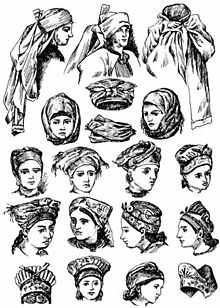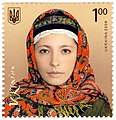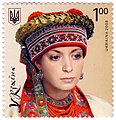
The ochipok (Ukrainian: очіпок, also намітка, namitka; перемітка, peremitka; серпанок, serpanok; рантух, rantukh; склендячка, sklendyachka; хустка, khustka) is a married woman's headdress as part of traditional Slavic folk dress, often decorated with embroidery. It is a cap that covers the entire head with a slit in the back and laces that pull it tightly around the head.
They were mainly worn by women in the middle Dnieper River region, including the Left-Bank and steppe areas, however the ochipok was also used in other regions of Ukraine. It is thought to have originated during the Hetmanate period. The specific characteristics of the ochipok varied from region to region.
In Europe in the Middle Ages, uncovered hair was a sign of virginity. A married woman covered her hair completely, including forehead, ears and often the neck.
Namitka is a long, thin fabric wrapped around the head and tied in the back. It was the original Slavic head covering for men and women, and could be used to cover the face. Eventually, it gave rise to the Russian kokoshnik. The ends of the fabric are embroidered, usually with red thread.
During the Ukrainian wedding ceremony, the bride's hair was covered by an ochipok and namitka. She would wear the ochipok for the rest of her life with various types of headgear on top of it.

Peremitka is part of traditional Hutsul dress. It is a long strip of cloth ornamented on both ends and tied with a knot on each side. It is worn wrapped around the hair, neck, and chin.
Bavnytsia is an embroidered ring of cloth fitted around the head, open at the top, with a ring of fringe or gathers stitched to the top edge. It was covered with a namitka or a kerchief. Bavnytsia was traditional dress in Galicia.
Instructions and examples of traditional Ukrainian headgear are on display at the Ivan Honchar Museum In Kyiv.
-
Ochipok and kerchief from Lviv
-
Namitka from Rivne
-
Bavnytsia and kerchief, from Lviv
-
Caul and kerchief
-
Bavnytsia, Pokuttia
-
Peremitka Hutsul style
-
Ochipok and peremitka
-
Bavnytsia, Donetsk
-
Namitka, 1820
-
Girl from Podillya c. 1800 by Vasily Tropinin
See also
References
- ^ Throw away your wedding rings – put on namitkas
- ^ Medieval maidens: young women and gender in England
- ^ "Украинские национальные костюмы Женские головные уборы". Archived from the original on 2011-11-10. Retrieved 2011-07-06.
- ^ Hutsul national dress
- ^ Costume of Javoriw county, Halychyna, Ukraine
- Natalya Poklad. Ukrainian National Costume As a Witness of the Past Welcome to Ukraine magazine
- "Dress" at the Encyclopedia of Ukraine
- "Традиційні головні убори подільських українців та їх роль у весільній обрядовості" at the Vinnytsia ethnographic museum (in Ukrainian)
- Ukrainian Folk Clothing










